TEAM YANKEE COLD WAR OR HOT WAR?
By Howard West
The premise behind is a miniatures wargame from Battlefront Miniatures is to be able to re-fight the battles of the Cold War that did not really happen. If you define the Cold War that did not happen as armed conflict between the Soviet Union and its Warsaw Pact Allies versus the NATO countries of Western Europe and the United States and Canada. Then the Cold War did not happen. The 1980s and into the early 1990s it was not a peaceful time, as various armed conflicts existed thru out the time frame of the Team Yankee Rule set. With Version 2 of Team Yankee 15 countries armed forces are represented covering some of the major countries of the Middle East, Soviet Union and the three largest Warsaw Pact Allies, and the six larger countries NATO.
Many of the 15 countries covered under Team Yankee V2 participated in the following wars or armed conflicts: The 1982 War in Lebanon, The Iran and Iraq War, The Soviet Afghan War, The Falklands War, The First Persian Gulf War. Some of the wars that occurred before the 1980s are also covered by Battle Front Miniatures in their and rules sets. So at the minimum the time frame covered by Team Yankee was at least pretty warm if not hot.
As a person who also plays Flames of War, if I want to have a better understanding on a specific topics such as: specific units, specific battles, vehicles, campaigns, etc… the amount of books and articles published on WWII is vast and you can spend a lifetime reading about the US infantry in WWII for example or reading about German tanks. With Team Yankee for a War that never happened you will need to dig a little deeper. Yes you could start with Harold Coyle’s Team Yankee or General Hackett’s the Third Word War or Tom Clancy’s Red Storm Rising all of which are good reads. But the focus on the above books is on a war that did not happen or what could happen, not what did happen.
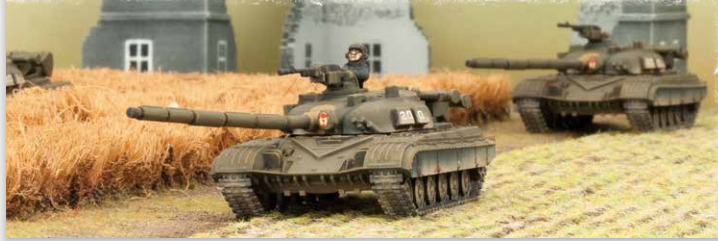
This research for this article actually started when I was playing my British Team Yankee army and our gaming group was participating in the two firestorm campaigns that Battlefront ran in 2017 and 2018, and . In both of these Firestorm Campaigns the authors mentioned the British Commandos and British Paratroops participating in their WWIII world. But then current Iron Maiden book at the time did not have any formations for them, nor does the current I book have them in it.
BTW if anyone form BF is reading this, those two Firestorm Campaigns where great and provided us with a lot of enjoyable games. You really need to be running these types of activities for the TY and FOW communities more often. One thing that happened at our group was the number of new players that it attracted and the amount of new TY products that where purchased by all of the participants. It also provided us a forum for players who are not tournament focused and just wanted to play a miniatures game on the Cold War.

The question that I had as I was playing in these two Firestorm Campaigns was, how would have the British Army performed in WWIII. Another question I had what was in the Para and Commando Brigades? What types of equipment did they have? How would you field them in Team Yankee? Could you make a realistic force in Team Yankee with them?
The premise behind Team Yankee and the two Firestorm Campaigns was that the Soviet and Warsaw Pact Armies attacked NATO in the Summer of 1985.
Coincidently both the British Paras and Commandos and other British Army units participated in the Falklands War in the Spring of 1982. From an historical point of view three years is pretty close. Now the question became how where they organized in the Falklands War and what types of equipment did they have etc…. And what changes occurred in these units by 1985. The British Army also participated the First Persian Gulf War but that conflict is beyond the scope of this article.
The next logical follow-up questions are what changes would be needed to the existing British Forces from the then Iron Maiden or the new British WWIII book need to have the Paras and Commandos work.
Earlier this year I did one of the articles for the new book for NO DICE NO GLORY and it gave me the ideas on how you could do the Paras and Commandos in Team Yankee. Also in the Free Nations Book, the authors commented on how the formation would be fielded and equipped via reserve stock equipment in Europe. If you wanted to the have the Britt’s participate in a Firestorm campaign game the British contingent would probably be the Commandos and Paras.
What is needed to make a Para or Commando formation?
On one of the Battlefront podcasts Peter Simunovich talked about their ability to do x many new models each year. So to do the British Paras or Commandos I will not be recommending any new models that where used by the Paras or Commandos. But it will require some new or updated cards and formations in forces.
Rest of this article will focus on how the British Commando and Paratroops would be organized and function in Team Yankee in the Summer of 1985, the intent is not to provide you with a set of formations to refight the Falklands Conflict.
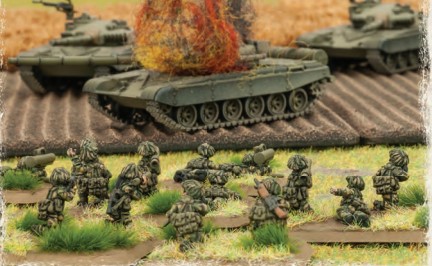
3rd Commando Brigade
The 3rd Commando Brigade in the Summer of 1985 was tasked to reinforce AFNORTH in either Norway or Denmark. During this time period it spent about a quarter of its year training with either the Norwegian or Danish armies. It was the British Armies only amphibious trained brigade and would be combined with Dutch Marine and Naval units to build NATO’s Naval Landing Force. The Commando Brigade was normally on a seven day move unit and at time of escalating tensions it would be upgraded to a 72 hour move unit.
The 3rd Commando Brigade was a self contained brigade that had permanently assigned support assets. In 1985 it consisted of 3 Commando Battalions, 1 artillery regiment of 4 6 gun 105mm towed batteries, 1 dedicated forward observer battery, they was trained to call in artillery, aircraft and ship bombardments, a dedicated Engineer Squadron, a Recce Troop, a Blowpipe Air Defense Troop, a Rapier Battery, a dedicated Air Squadron of Gazelle and Lynx Helicopters, Medium Recce Squadron and several SAS/SBS attachments. All of these units had participated in the recent Falklands War.
Commando Formation
Commando Battalion Units
Commando Battalions had a HQ Section and 3 Infantry Companies and a Support company. The Infantry Companies had a HQ Section and 3 Infantry Troops.
In the summer of 1985 the Commando Infantry companies where organized similarly to their Mechanized brothers, but with out the FV432. I would change the costing by -1 point per troop. In the West German Book the cost to add M-113s to the West German Jager formation so why not just subtract one from the British Mechanized Infantry.
Note: The Commandos have Troops instead of Platoons.
Since I do not have access to the Battlefront Secret Code for unit points, I would also have the Commandos have 3 for Morale and Rally. Also they should the have MOUNTAINEERS special rule. Or just use them as supplied today from the existing FV432 Mechanized Platoon Card.
In the Falkland’s War the Commandos upgraded one of the riflemen in each of the fire team with the Carl Gustav and armed them with a Bren Gun to provided additional automatic weapons fire. Not sure how you would do that without changing the ROF ratings of the Carl Gustav team. You will definitely need a new card to reflect this, A simpler way maybe to just a add additional SF GPMG or GPMG-Law team to the Commando troop. I’m assuming the Commandos would find the same Bren Guns in storage and dust them off and take them with them in the Summer of 1985. It is not clear in my readings if this became a permanent change to the Commando Battalions TO&E post Falklands War. I did find a reference point that when the Commando Brigade deployed to Norway for a NATO exercises and training they went equipped this way.
ANTI-TANK Troop
The Commando Battalions have completed their migration from Wombat Recoilless Riffles to Milan’s, they number between 14-18 Milan’s per battalion. They are part of the battalion support company that also has the mortar battery and the machinegun platoon in it. The anti-tank platoons should not have any FV432 transport tracks for them. The Anti-Tank Troop was part of the Battalions Support Company.
SF GPMG Section
Use the existing number of SF GPMG teams that are at the Company HQ Section.
Mortar and Artillery Batteries
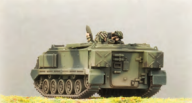
Currently in V2 of Team Yankee you do not have the ability to field non Tracked Mortars or Artillery. In the book the ANZAC “drew vehicles and equipment from reserve stocks”, my assumption is that their are a few extra FV432 Mortar tracks sitting around for the Commandos to use. Also in the Book the GEBIRGSJAGER have M-113 120mm Mortar tracks.
This way of fielding the Mortars is keeping within the spirt of the current Team Yankee Rules of NO foot based Mortars, which I agree with the approach that Battlefront has taken with that.
The Mortar Battery was part of the Battalions Support Company and assigned to an Commando Infantry Company as needed.
Currently in V2 of Team Yankee you do not have the ability to field non Tracked Mortars or Artillery. In the book the ANZAC “drew vehicles and equipment from reserve stocks”, my assumption is that their are a few extra Abbot’s sitting around for the Commandos to use.
The Artillery Batteries that supported the Commandos had 6 gun batteries. It would be nice to have a Abbot card that has 3 and 6 gun battery options.
This way of fielding the Abbot Batteries is keeping within the spirt of the current Team Yankee Rules of NO foot based Artillery, which I agree with the approach that the authors and Battlefront have taken with this. The Abbot Battery was assigned to a Commando Infantry Company as needed.
Medium Recce Troops
The Recce troops where organized differently than the exiting Scimitar and Scorpion Troops in the British WWIII book, instead of having 2 or 4 Scimitar or Scorpions they had 2 Scimitars and 2 Scorpions in a single troop. The Medium Recce Troop was assigned to the Infantry Company.
Support Units for a Commando Formation
Medium Recce Squadron
The Commando Brigade had a Medium Recce Squadron attached to it during the summer of 1985. The Recce troops where organized differently than the exiting Scimitar and Scorpion Troops in the British WWIII book, instead of having 2 or 4 Scimitar or Scorpions they had 2 Scimitars and 2 Scorpions. Rest of the Squadron would be the same as in the British WWIII book.
Air Defense Units
In the Summer of 1985 the Commando Brigade and both a foot Blowpipe Troop and a towed Rapier Battery. Just use the existing Blowpipe and Rapier that are available today. I assume that additional Air Defense units would be assigned to them similarly to what happened in the Falklands War that added additional air defense units to the 3rd Commando Brigade and 5th Infantry Brigade.
Battlefront does have the figures for ground based blowpipes, the come in every Spartan or Striker Troop box we just need a card and points for them.
AIR ASSETS
In the the Summer of 1985 the Commando Brigade had a dedicated Air Squadron of 8 Gazelle Scout Helicopters and 4 Lynx Anti-Tank Role. Helicopters. I would allow the British player to purchase up to two of the existing French Gazelle Gunslinger units but without the gunslinger, plus the existing Lynx Anti-Tank units. In the Falkland War the Britt’s used their Scout and Gazelle helicopters in a variety of roles and close air support was one of them. Also in the Falklands the Britt’s added SNEB Rocket pods to their helicopters, have not come across if that configuration was actually used.
The Commandos would also have access to the existing Harrier Close Support Flight.
Forward Observer – Just use the existing FV432 FOO
5th Airborne Brigade
In 1983 the 5th Infantry Brigade was renamed the 5th Airborne Brigade in the Summer of 1985 was part of the national reserve based in the UK. In the Summer of 1985 it consisted of 2 Paratroop Battalions, 1 Gurkha Battalion, 1 Light Infantry Battalion,1 artillery regiment of 4 6 gun 105mm batteries, a dedicated Paratroop Engineer Squadron, a Recce Troop, a Blowpipe Air Defense Troop, and a dedicated Air Squadron of Gazelle Scout Helicopters and Lynx Ant-Tank Helicopters, 1 Medium Recce Squadron. The Majority of these assets had participated in the recent Falklands War as part of the 5th Infantry Brigade or attached out to the 3rd Commando Brigade.
Note: The Para Territorial Battalions did have a specific NATO Task to support the rear area of the 1st Armored Division in Germany. These Battalions where organized differently than the Regular Army Para Battalions and is beyond the scope of this article.
Paratroop Battalion

The major difference between the Paras and the Commando units from a Team Yankee point of view is how the infantry platoons are organized. The existing Lynx Airmobile Company is the closet match. I would change the costing by allow the Paras to purchase 1 Carl Gustav section for each platoon for +1 point per platoon. In the West German Book the cost to add a Carl Gustav to either a Marder-1 or a Marder-2 Platoon is +1, so why not to the British Para Platoons. During Falklands War and Post Falkland’s the British Para Infantry Platoons where organized with 1-HQ section with the 50mm MTR and the Carl Gustav and 6 GPMG teams with Laws + attached Milan’s.
This organization was unique to the Paras. I’m currently not sure if the Lynx Airmobile Platoon is organized correctly in Team Yankee and do not want to go there in this article. I would also allow you to add a 3rd Infantry Platoon to each Para Infantry Company. Like the Commandos I would have the Paras have a 3 for Morale and Rally. Or just use them as supplied today Lynx Airmobile Platoon. As I stated previously, I do not have access to the Battlefront Secret Code for unit points, so I can not speculate what the points would be for the 7 GMPG + Milan’s or the improved rally and morale would be.
Paratroop ANTI-TANK Platoon
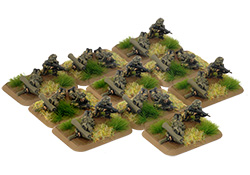
Since we are using the Lynx Airmobile Company for the base formation formation, I would limit the number of Milan’s for the Para Anti-Tank platoon to 4 or 6 Milan’s.
Recce Troops, Mortar and the Artillery Batteries would be the same as the Commando formation listed above.
Air Defense Units would be the same as the Commando formation listed above.
Air Assets would be the same as the Commando formation listed above.
Forward Observer – Just use the existing FV432 FOO
Missing Units
The major component that is missing in both the Commando and Paratroop Battalions, are infantry based recce units. These existed in every Commando and Para battalion in the Falklands War and where in the battalions going forward and also probably existed in the Air Mobile Company that is in the current Books.
The 2nd Missing unit that was in the 5th Infantry Brigade only, where .50 Cal ground based AA machine gun teams. I doubt if they had the phone call to deploy the European theater like it is stated in the two Firestorm Campaigns, they would have left them behind.
Conclusion
I hope you found this article interesting, please leave comments and suggestions below. I normally get back to them with in a few days of posting. I think the wearers of the Green Berets and Red Berets need to be part of Team Yankee. My suggestions to how that may occur is a approach to this and fits into the current V2 Team Yankee World and has been done before in other Team Yankee Army books. And does not require any new figures just a few updates to existing cards and some new formations in forces.
I think the Paras or Commandos would make a decent formation but will need to be paired up with another British or NATO allied formation. If you go back to the Firestorm Stripes campaigns the authors talked about the US Marines and the 3rd Commando Brigade landing in Denmark or the North German coast. I could see pairing up a Commando formation with a Marine M-60 formation to participate in Firestorm Stripes or the Britt Paras pairing up with a Dutch LEO-1 formation to hold Arnhem as described in Firestorm Red Thunder.
My 3rd reason for doing this was to answer my question of, how would have the British Army performed in WWIII.
I think I will let Major General John Frost answered that with quotes from his book on the 2nd Para: “If the campaign in the Falkland Islands could be said to have had one really beneficial result, it is in the conformation of abilities of the modern generation of servicemen.” He goes on to state that “They faced the hard pounding and rigors of real warfare conducted with modern weapons”.
Sources
Below is my sources that I used to write this article, this is a small portion of the number of books and on line resources that have been published on the Falklands War.
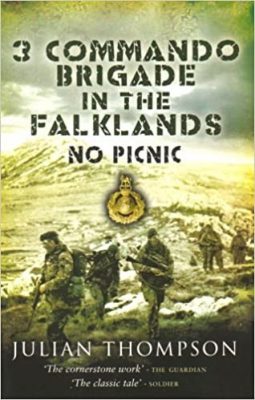 The 3rd Commando Brigade in the Falklands: No Picnic By Major General Julian Thompson (Penn & Sword 1985, 1992, 2001 & 2008)
The 3rd Commando Brigade in the Falklands: No Picnic By Major General Julian Thompson (Penn & Sword 1985, 1992, 2001 & 2008)
The author Major General Julian Thompson commanded the 3rd Commando Brigade in the Falklands War. He takes you from the 3:15AM phone call, when the Argentinian’s invaded the Falklands to the conclusion of the war. I personally like the beginning of the book on how they quickly assembled the existing 3rd Commando Brigade that had some of its assets scattered around the world. Then packing up the brigade and taking them on the first stage of their travels to Accession Island. And also how they acquired other assets for the 3rd Commando Brigade.
If you would ask me, I only want to read one book on the Falklands War what should I read? I would recommend this book.
This book is what started me on my journey on reading and digging into how the British Army fought in the Falklands War and how they might look like in Team Yankee.
 Falklands Gunner A Day-By-Day Personal Account of the Royal Artillery By Tom Martin (Frontline Books 2017)
Falklands Gunner A Day-By-Day Personal Account of the Royal Artillery By Tom Martin (Frontline Books 2017)
The book is his day to day view from a young Lieutenant in the Falklands War as a command post commander in the 29th Corunna Artillery Battery from the 4th Royal Artillery Regiment. The Battery was given the Battle Title Corunna from its efforts in the British Army’s 1808/1809 Campaign vs the French under Marshal Soult.
I really liked this book, he takes you into the gory details of being an Artillery Officer at the Battery level. From how they had to move the Batteries, digging them in again and again. Stacking and re stacking the artillery’s rounds, prepping the rounds for firing, setting the guns and firing. I was also surprised on how they where partially responsible for patrolling the area near where their guns deployed. The 29th Battery came with the 2nd Para from the then 5th Infantry Brigade and assigned to the 3rd Commando Brigade. He also take you thru the details of packing up the battery and troops aboard their ships and what they did for the multi week travel from the UK to the Falklands Islands.
The Forward of the book was written by Major General Julian Thompson, in his forward he said the following: “Unlike Air Support which is often not available, or impossible to deploy because of darkness, rain or snowstorm, the artillery can provide support whatever the weather, or time of day”, “It is on tap 24/7”, “It can be switched to engage new targets” and “can sustain support through long hours of the battle” Think about that the next time your A-10’s, SU-25’s or Tornados do not show up.
 WITH 3 PARA TO THE FALKLANDS By Graham Colbeck (Greenhill Books 2002)
WITH 3 PARA TO THE FALKLANDS By Graham Colbeck (Greenhill Books 2002)
At the time of the Falklands War Graham Colbeck was a Sargent in the 3 Para’s. Again like the first two books I really like how the author walks you thru the news of the Argentine invasion and the news that the battalion would be going with the 3rd Commando Brigade to the Falklands, instead of the 5Th Infantry Brigade. Sargent Colbeck was the Senior NCO of the Milan section of the Battalions Anti-Tank platoon. I purchased this book originally because I wanted to understand how an ATGM Anti-Tank unit worked and is it reflected in Team Yankee correctly. Thru out the book you read how the Milan ATGM was used to provide covering fire for the advancing infantry as they moved to engage the dug in Argentine infantry or weapons teams.
The 2nd point of information was that the 3rd Para was in the process of converting to Millan’s from the Wombat Recoilless Riffle in the Battalions Anti-Tank Platoon. And also that they left the Wombats on their transport ship and the Wombat Section landed with 3 Carl Gustav and 3 GMPG sections that would be attached out as needed to the infantry companies.
Sargent Colbeck’s book is a very easy and enjoyable read, as I read the book he sounded and talked like two of my gaming buds. One of them a Vietnam Veteran who did two tours in the 101st Airborne and the other who did four tours in Afghanistan in the 82nd Airborne Division. Maybe they went to the same Airborne speak training class?
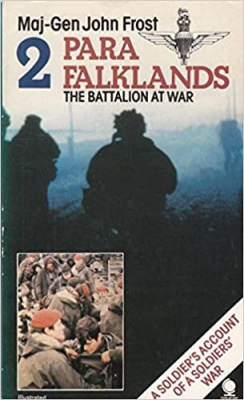 2 PARA FALKLANDS: The Battalion At War By Major-Gen John Frost (Buchan & Enright 1983)
2 PARA FALKLANDS: The Battalion At War By Major-Gen John Frost (Buchan & Enright 1983)
What is very interesting about the author of this book was that 40 years earlier, then Major Frost commanded the 2nd Para thru the North African Campaigns, Sicily, Southern Italy Landings and Finally Arnhem in September 1944.
He brings the reader a different view than the previous books, almost like a fatherly figure talking to you about one his children. Thru out the book you can feel his pride in his unit and of what they accomplished.
The book does not spend as much time on the early portion of getting ready for the move to the Falklands. At the time of the Argentine invasion of the Falklands the battalion was get ready for rotation to Belize. The advanced team was already in Belize and rest of the battalion was to follow shortly. Like the 3rd Para, the 2nd Para was part of the 5th Infantry Brigade and was assigned to the 3rd Commando Brigade. As you read thru the book, you will find some over lap at a high level with the previous books especially since the 29th Corunna Battery provided many fire support missions for the 2nd Para and in Major General Julian Thompson’s book he was giving orders to the 2nd Para.
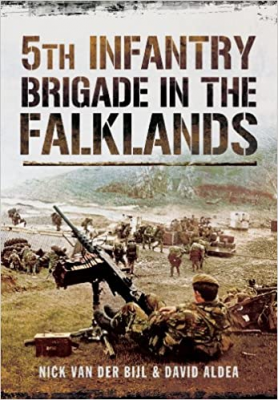 5th INFANTRY BRIGADE IN THE FALKLANDS By Nick Van Der Bijl and David Aldea (Pen & Sword 2014)
5th INFANTRY BRIGADE IN THE FALKLANDS By Nick Van Der Bijl and David Aldea (Pen & Sword 2014)
Imagine being the Brigade Commander of the 5th Infantry and on April 7th and for the last 5 days you have watched a large portion of your command being moved to the 3rd Commando Brigade and those troops are getting packed and shipped on April 9th and then you are told that your Brigade is going south to the Falklands. You then start working with the ministry of defense to acquire 2 other infantry battalions and various support assets.
The authors walk you thru this process and the eventual travel to the Falklands and the important role they played in the final days of the Falklands War. The authors do a nice job at walking you thru the various challenges that the 5th Brigade had in integrating all of these units together in a very short time period.
Thru out the book the authors also explain what was happening from the Argentine Army’s view point. This is unique to this book.
One of the reason I purchased this book was to read about how the Regular British Army Units performed in the Falklands War.
THE FALKLANDS 1982 Ground Operations in the South Atlantic Campaign #244 (Osprey Publishing 2012)
This is like the many books that Osprey Publishing has in their Campaign Series and provides a high level overview of the Falklands War with the focus on the ground operations.
Scorpion Reconnaissance Vehicle 1972–94 New Vanguard #13 (Osprey Publishing 1995)
This a very good overview of this class of vehicles and covers all of the variants, not just the Scorpions, the conflicts that they had participated in and the various countries that use them.
Note:
Just a point of reference on the above books, I was able to purchase all of the above used books at various dealers from across the country.

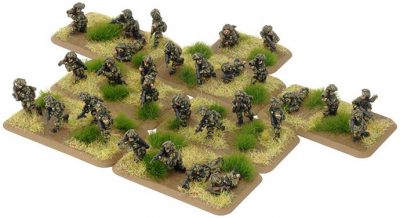



Nice job, Howard.